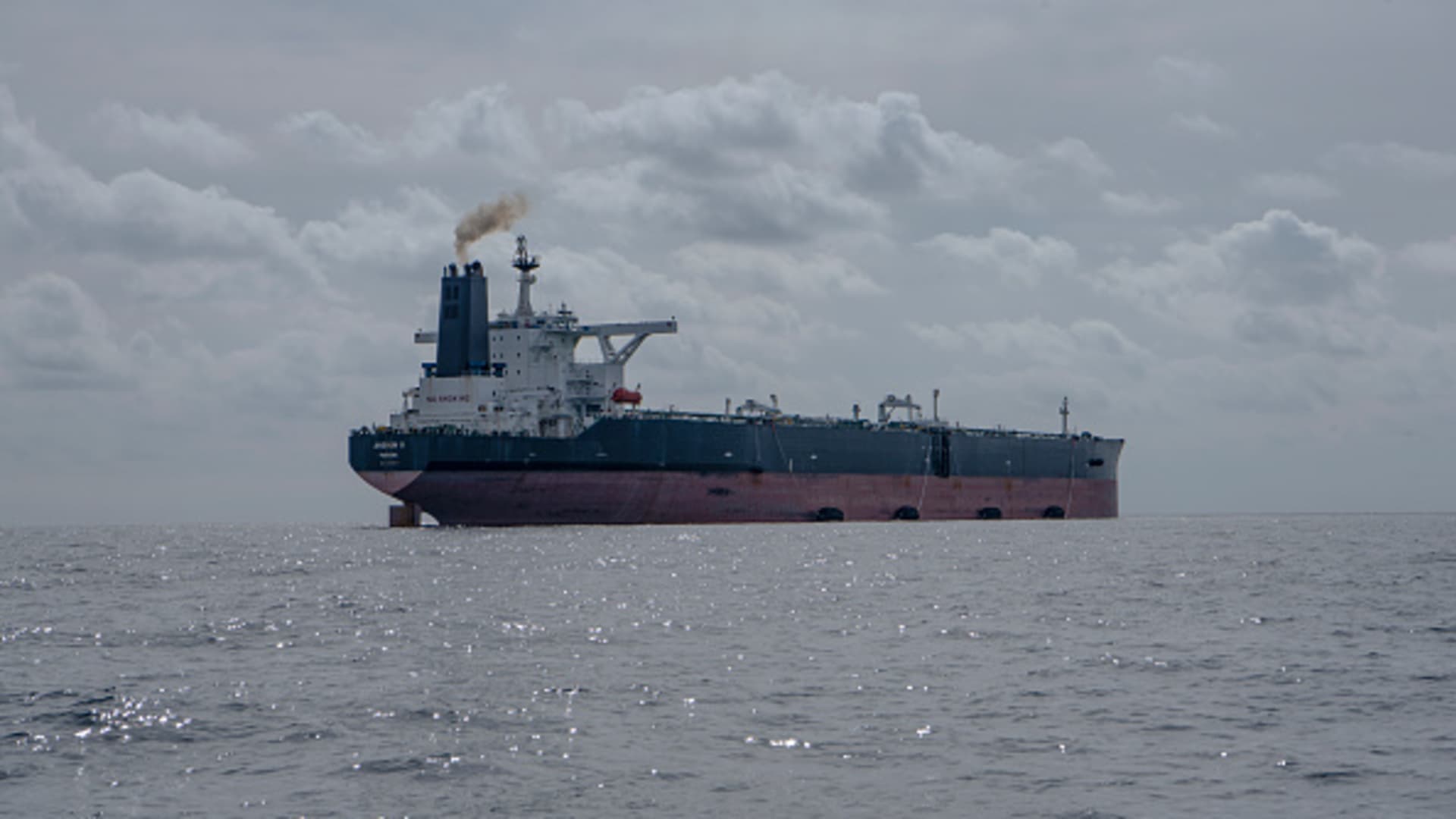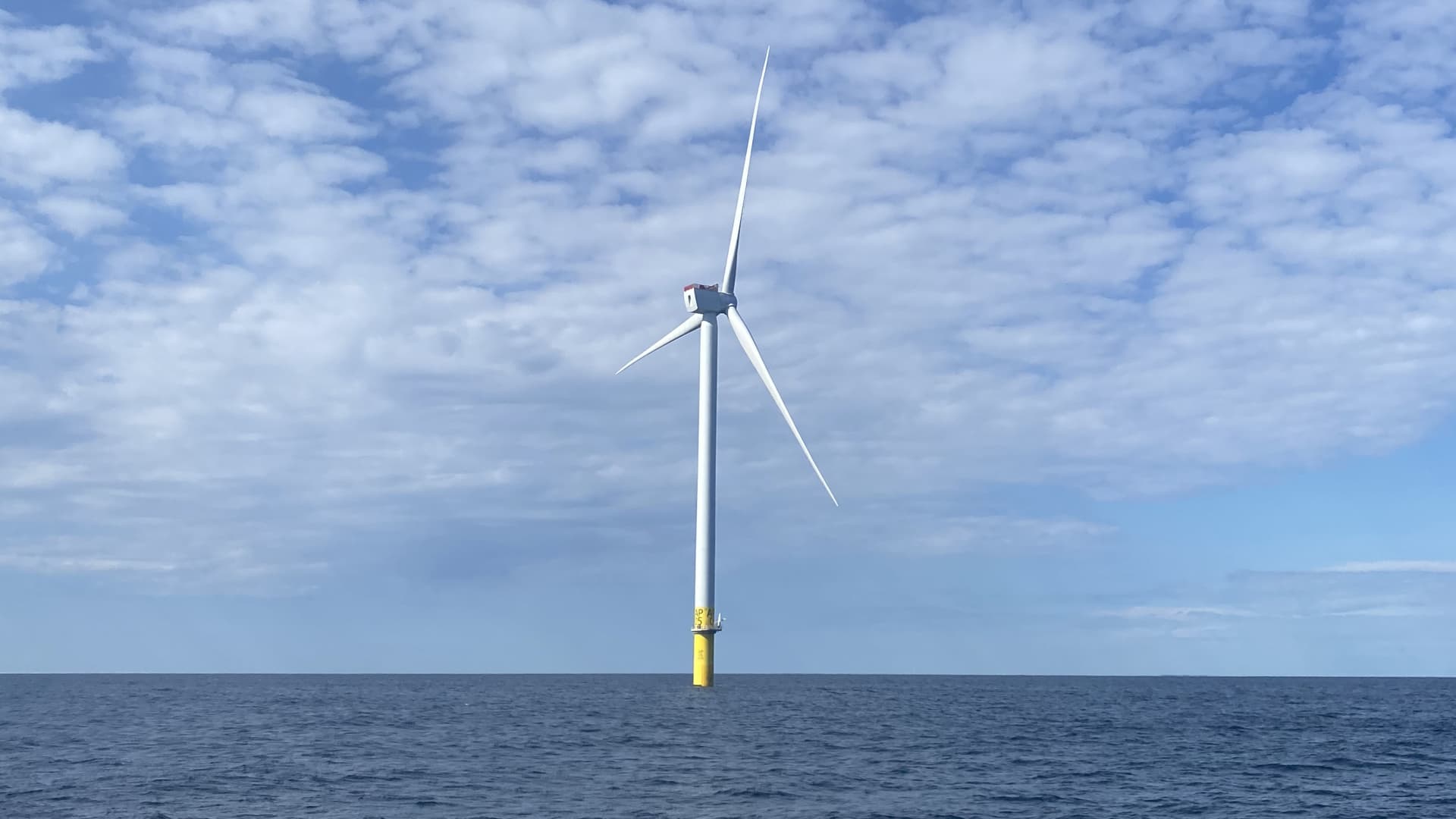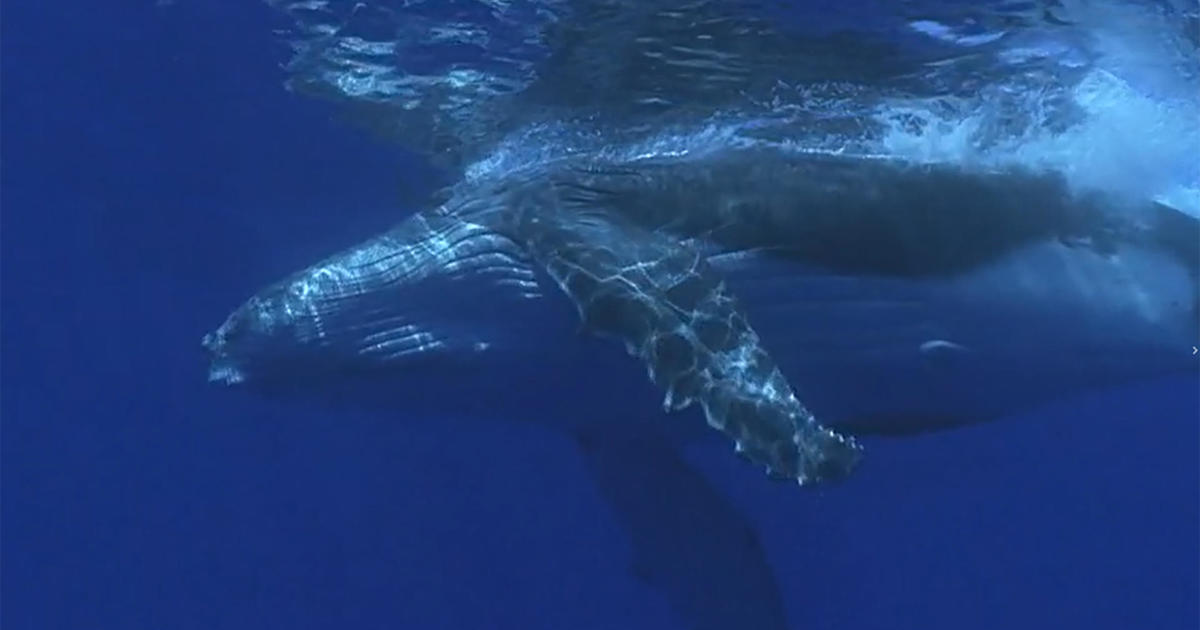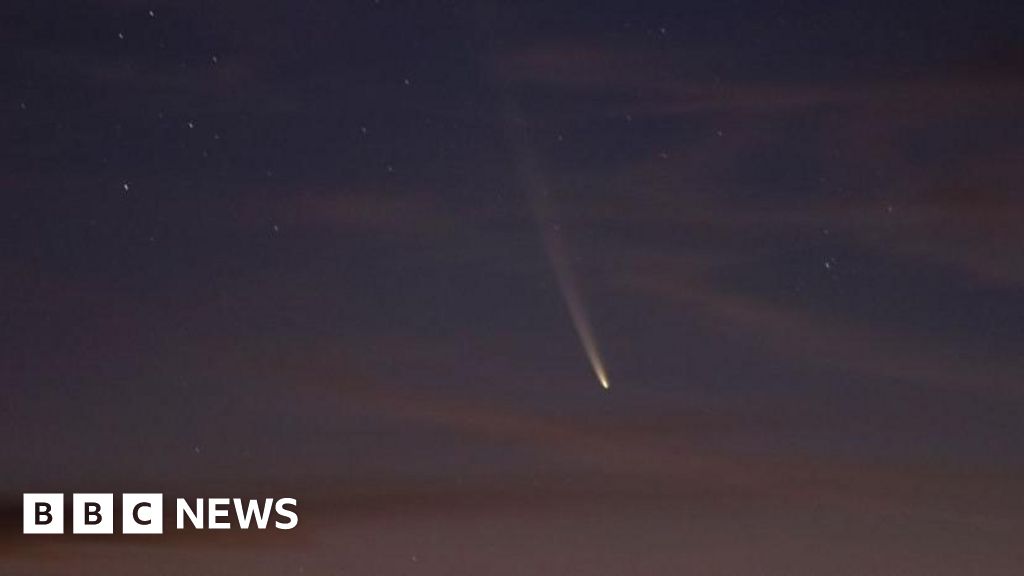Science & Environment
Google inks deal with nuclear company as data center power demand surges

People take photos in front of a giant Google logo at Google’s Bay View campus in Mountain View, California on Aug 13, 2024 where the “Made by Google” media event was held today.
Josh Edelson | AFP | Getty Images
Google said Monday that it will purchase power from small modular reactor developer Kairos Power, as tech companies increasingly turn to nuclear power as a way to fulfill the growing energy demands from data centers.
The tech giant said it will purchase power from a fleet of SMRs made by Kairos Power. Google said purchasing from multiple SMRs sends an “important demand signal to the market,” while at the same time making a long-term investment to accelerate commercialization.
“We believe that nuclear energy has a critical role to play in supporting our clean growth and helping to deliver on the progress of AI,” Michael Terrell, senior director for energy and climate at Google, said on a call with reporters. “The grid needs these kinds of clean, reliable sources of energy that can support the build out of these technologies. … We feel like nuclear can play an important role in helping to meet our demand, and helping meet our demand cleanly, in a way that’s more around the clock.”
The company did not disclose the financial terms of the deal.
There are only three SMRs that are operating in the world, and none in the U.S. The hope is that SMRs are a more cost-effective way to scale up nuclear power. In the past, large, commercial-scale nuclear reactor projects have run over budget and behind schedule, and many hope SMRs won’t suffer that same fate. But it is uncharted territory to some extent.
Kairos Power, which is backed by the Department of Energy, was founded in 2016. In July, the company began construction on its Hermes Low-Power Demonstration Reactor in Oak Ridge, Tennessee. Rather than use water as the reactor coolant – as is used in traditional nuclear reactors – Kairos Power uses molten fluoride salt.
Google said the first reactor will be online by 2030, with more reactors going live through 2035. In total, 500 megawatts will be added to the grid. That’s much smaller than commercial reactors — Unit 4 at Plant Vogtle, which came online this year, is 1.1 gigawatts, for example — but there’s a lot of momentum behind SMRs. Advocates point to lower costs, faster completion times, as well as location flexibility as reasons.
Monday’s announcement is another example of the growing partnership between tech companies and nuclear power. Data centers need 24/7 reliable power, and right now nuclear is the only source of emissions-free baseload power. Many hyperscalers have ambitious emissions-reduction targets, which is why they’re turning to nuclear power.
Constellation Energy is restarting Three Mile Island to power Microsoft data centers, while Amazon bought a data center from Talen Energy that’s powered by the Susquehanna nuclear power plant. Bill Gates, Sam Altman and Jeff Bezos have all backed nuclear companies.
Earlier this year, Google said its emissions have grown nearly 50% relative to 2019 thanks in part to an increase in data center power consumption.
“It is an incredibly promising bet, and one that, you know, if we can get these projects to scale and then scale globally, will deliver enormous benefits to communities and power grids around the world,” Terrell added.
Science & Environment
Russian oil trade rises with record volumes of ‘dark fleet’ crude

A Russian-chartered oil tanker in the sea off Morocco in an area identified by maritime technology company Windward as a hub for smuggling oil.
Europa Press | Getty Images
Recent data shows the discount on Russian oil narrowing and exports increasing despite the G-7 price cap on Russian petroleum exports and U.S. sanctions.
According to Clearview Energy Partners, Russian crude prices over the last four weeks have averaged about six cents below the Brent crude price. That is far off the trading discount when the cap was first put in place. When the cap was fully phased in, in February 2023, Russian crude was selling at a 30% discount. A year ago, the discount was about 16%.
Ukraine allies, including the U.S., have banned the import of Russian crude, while a price cap imposed on Russian oil by the G7 countries, the European Union and Australia bans the use of Western maritime services such as insurance, flagging and transportation when tankers carry Russian oil priced at or above $60 a barrel to nations where a ban is not enforced.
In a recent report to clients, Clearview Energy Partners characterized the G-7 price cap on Russian petroleum exports to third countries as “increasingly loose.”
Kevin Book, managing director of research at Clearview Energy Partners, told CNBC that despite the G-7’s June and September calls for improving the price cap, and recent guidance urging parties to Russian petroleum transactions to better scrutinize cargoes, “a U.S. pinch on Russian petroleum seems unlikely until after the election.”
“A cap enforcement crackdown runs the risk of driving up crude prices,” he said. “Plus, using ‘secondary’ sanctions to enforce the cap could push reputable insurers out of the Russian crude game entirely, leaving the market to potentially insolvent stand-ins.”
Book explained that part of the narrowing of the discount is a result of Russian oil finding additional buyers, including India and China.
Record volumes of sanctioned Russian oil were carried by the “dark fleet” and known sanctioned tankers without known insurance over September, according to a recent report from Lloyd’s List.
The Lloyd’s List Intelligence unit analysis of data from energy cargo tracking firm Vortexa revealed that 69% of all crude shipped in September was carried on dark fleet tankers and 18% was carried on tankers owned by Russian government-controlled Sovcomflot. It is the most volume moved since tracking of the monthly dark fleet data began in mid-2022 (measured by deadweight capacity of vessels.) In May, 54% was recorded, the previous high.
Chinese and Indian oil traders, refiners, and port authorities were the drivers of this growth.
Lloyd’s List determines if a tanker is part of the dark fleet based on factors including if the ship is 15 years or older, is anonymously owned or has a corporate structure designed to conceal ownership, is handling sanctioned oil trade, and is using deceptive shipping practices. Its analysis showed a flurry of flag-hopping, where a vessel changes its country registration, as well as ownership and management changes amongst the vessels in the dark fleet to avoid detection.
The dark fleet data does not include Russia’s Sovcomflot or Iran’s National Iranian Tanker Co.
Its data revealed that 5% of all Russian oil in September was transported by 11 tankers, with nine of those vessels sanctioned by the UK or EU between July and September and owned by the Russian government-controlled tanker company Sovcomflot. The remaining vessels were sanctioned by the U.S. Office of Foreign Assets Control for breaching sanctions on Syrian and Iranian oil. Those vessels are the Eternal Peace and Nebulax.
Some of the Sovcomflot tankers that Lloyd’s List identified in its report were sanctioned by the UK or EU between July and September. Some tankers changed vessel names, reflagged the vessel’s origin to Barbados, or redomiciled registered ownership to Seychelles and changed their ship management to a newly incorporated UAE-based ship manager, Avebury Shipmanagement.
Greece-owned tankers have shipped 23% of oil from Russia in September, consistently over the last three months, according to Lloyd’s List. The majority of the UK- and EU-sanctioned tankers have already discharged their oil in China.
Andy Lipow, president of Lipow Oil Associates, said despite the price cap, some ship owners have decided that it was extremely profitable to have their vessels become part of the dark fleet and risk United States and EU sanctions.
“After all, Russian oil continues to be purchased by Chinese and Indian refiners with little repercussions from the U.S. or EU,” said Lipow.
A Treasury spokesperson told CNBC, “Two years since the price cap was implemented, it is unsurprising that Putin is still sinking money into building and maintaining a shadow fleet to escape the Coalition’s sanctions: that evasion costs the Kremlin, and diverts money that would otherwise be going to the battlefield. The Price Cap Coalition continues to engage with industry to ensure compliance with the price cap and to increase Putin’s costs of going outside it.”
The number of uninsured vessels carrying sanctioned oil also increased, according to Lloyd’s List, with some 201 of the 310 tankers tracked not having insurance with the 12 clubs that form the International Group of P&I Clubs. That represented 68% of the vessels when measured by deadweight, and the lowest number of tankers tracked with IG club insurance, surpassing 67% uninsured recorded in July and August.
Lipow said the oil market is pricing in a greater probability of a war between Iran and Israel that could impact supply.
“The biggest risk to the oil market is the closure of the Straits of Hormuz, and while unlikely, if it were to happen, oil prices would rise $30 per barrel,” he said. Despite the hostilities, oil prices remain under pressure, he said, as increased production from the U.S., Canada and Guyana adds to the supply picture while OPEC+ delays the restoration of its production cuts.
The increased use of dark fleet vessels comes with greater maritime safety and environmental risks.
Lloyd’s List warned in a recent note that shipping safety has become a “casualty of economic sanctions” with attempts to enhance sanctions policy leading to greater ranks of tankers determined to evade it.
Insurance giant Allianz said in May that dark fleet tankers had been linked to more than 50 accidents.
Lipow told CNBC if these vessels were to be involved in an accident that resulted in an oil spill, the owners — assuming they could be identified and found — would simply walk away, leaving the mess and subsequently the cleanup for someone else to do.

Science & Environment
WTI, Brent fall after China press briefing


Crude oil futures fell more than 2% on Monday after a press briefing by China’s finance minister disappointed the market.
Traders have been banking on more robust stimulus in China to boost the world’s second-largest economy. Soft demand in the world’s largest crude importer has weighed on the market for months.
“China’s monetary stimulus measures failed to stimulate and the weekend’s pledge from the finance ministry to borrow more was long on cliches and phrases but short on reassuring and convincing details,” Tamas Varga, analyst at oil broker PVM, told clients in a note.
Here are Monday’s energy prices:
- West Texas Intermediate November contract: $73.93 per barrel, down $1.63, or 2.16%. Year to date, U.S. crude oil has gained about 3%.
- Brent December contract: $77.44 per barrel, down $1.60, or 2.02%. Year to date, the global benchmark is little changed.
- RBOB Gasoline November contract: $2.1044 per gallon, down 2.19%. Year to date, gasoline is little changed.
- Natural Gas November contract: $2.572 per thousand cubic feet, down 2.28%. Year to date, gas is ahead more than 2%.
The market, meanwhile, continues to monitor the Middle East in anticipation of a retaliatory strike by Israel against Iran. U.S. officials told NBC News that Israel has narrowed down the targets it plans to hit. These include military and energy infrastructure, the officials told NBC.
Science & Environment
The first U.S. commercial-scale offshore wind project

GREENPORT, N.Y. – Roughly 35 miles off the east coast of Montauk, New York, 12 turbines gently spin in the wind at Orsted’s newly developed South Fork Wind farm. The project, which connected to the grid earlier this year, is the first commercial-scale offshore wind farm in the U.S., providing enough power for 70,000 homes annually.
It’s a needed bright spot for the U.S. offshore wind industry, which has faced a number of challenges getting off the ground. Rising interest rates and supply chain snags have changed project economics, forcing some developers to return to the market in search of higher contracted prices. Other projects have been canceled entirely.
Soren Lassen, head of offshore wind research at Wood Mackenzie, said the U.S. offshore wind industry is going through a needed readjustment, and that while the long-term outlook remains intact, progress has been pushed out. South Fork Wind offers tangible evidence that wind projects can work.
A long-term investment
Traveling by way of a high-speed ferry from Greenport, New York, it takes about two hours to get to South Fork Wind. It’s hard to get a sense of just how large these turbines are until you’re right under one: they tower 460 feet above the water, with blades that are each longer than a football field. And that’s just what the eye can see. Underwater, each tower sits atop a custom foundation drilled into the seabed. Apart from the gentle “swoosh” of the blades – only audible when right next to the turbine – the wind farm is otherwise quiet in the middle of the ocean.
South Fork Wind’s substation, which is connected to the power grid in East Hampton via a subsea and then underground cable.
Pippa Stevens | CNBC
Each turbine is connected to an offshore substation – the first of its kind built in the U.S. – which is connected to the local power grid in East Hampton, New York, via a 65-mile subsea and underground cable.
South Fork Wind was not without opposition. The waters off the Long Island coast have long been a place for recreational and commercial fisherman alike, some of whom opposed the project. Residents in Wainscott – the summer community where the cable comes ashore – also fought it. This led to Orsted adding extra space between each turbine so that the area remains open both to transit by pleasure and fishing boats, and the company buried the onshore cable beneath the beach and local roads.
Denmark-based Orsted is not new to the area. The company developed the five-turbine Block Island Wind Farm, which is northwest of South Fork Wind, in 2016. And northeast of South Fork Wind sits Revolution Wind – a 65-turbine project that Orsted broke ground on in 2023. In July, Orsted began construction on Sunrise Wind, which is also in federal waters off the New York coast.
Offshore wind projects are long-term investments, with work starting years before a single foundation is even drilled into the seabed. Securing the necessary permits is a lengthy process.
The Bureau of Ocean Energy Management first awarded the leases for South Fork Wind in 2013, which where acquired by Deepwater Wind. Orsted acquired the company in 2018 and partnered with Eversource Energy to start building the project. Onshore construction began in February 2022, with offshore construction following in 2023. In September, Skyborn Renewables, a Global Infrastructure Partners portfolio company, acquired Eversource’s 50% stake in both South Fork Wind and Revolution Wind.
South Fork Wind, which is 35 miles East of Montauk, New York.
Pippa Stevens | CNBC
Offshore wind developers typically use power purchase agreements, which are signed ahead of construction. Put simply, it’s a long-term agreement between the owner and a third party who agrees to pay a specific price for the power – oftentimes for 20 years or more. At South Fork Wind, the power is being sold to Long Island Power Authority.
While this model provides long-term certainty, it can also be a huge obstacle if project costs balloon. Orsted is developing Revolution Wind and Sunrise Wind, but last year it walked away from Ocean Wind 1 and 2, which were slated to be built off the coast of Atlantic City, New Jersey.
“Macroeconomic factors have changed dramatically over a short period of time, with high inflation, rising interest rates, and supply chain bottlenecks impacting our long-term capital investments,” David Hardy, CEO Americas at Ørsted, said in October 2023. “As a result, we have no choice but to cease development of Ocean Wind 1 and Ocean Wind 2.”
In May, Orsted agreed to pay New Jersey a $125 million settlement.
The financial problems are not unique to Orsted. Equinor and BP ended a joint venture to develop a project in waters off the coast of New York in January. Equinor took sole ownership of the project and re-entered the market in search of better prices – securing a deal for Empire Wind 1, but not for Empire Wind 2, which remains on pause.
High rates, supply chain struggles
The two main obstacles around building offshore wind farms are interest rates and the supply chain. Offshore wind is capital intensive: it takes a lot of money to build one of these projects in the middle of the sea, and as interest rates rose companies’ cost of capital surged. At the same time, raw material and labor costs accelerated out of the pandemic. It’s hard to begin construction without a PPA locked in, but if costs rise significantly above initial estimates, the PPA might not be high enough for the project to be feasible.
Each turbine at South Fork Wind rises 460 feet above the water.
Pippa Stevens | CNBC
Much of the supply chain is also highly specialized. There are only a few vessels in the world, for example, that can lay the underwater cables. Turbine installation vessels are also industry-specific. The offshore wind industry is not new globally, but it is in the U.S., meaning just a few years ago a domestic supply chain was virtually nonexistent.
But some of those supply chain constraints are beginning to ease as more and more projects get off the ground. Dominion Energy is building the first Jones Act-compliant turbine installation ship in Brownsville, Texas, which will be used to transport supplies to its Coastal Virginia Offshore Wind project. Once the project is completed, the ship will be contracted out to other companies.
‘Not disappearing’
Offshore wind port hubs are also popping up, including the South Brooklyn Marine Terminal, the Port of Virginia and Connecticut’s Port of New London. Orsted’s domestic supply chain now spans more than 40 states, and work for South Fork Wind took place in New York, South Carolina, Texas, Rhode Island and Connecticut, among other states.
The U.S. Department of the Interior recently approved its tenth offshore wind project – this one in Maryland – in what it called a “major milestone.” But the Biden administration’s goal of 30 gigawatts of offshore wind power by the end of this decade remains far off.
South Fork Wind’s offshore substation is the first-of-its-kind built in the U.S.
Pippa Stevens | CNBC
Vineyard Wind, off the coast of Martha’s Vineyard and Nantucket, Massachusetts, is the only other commercial-scale offshore wind project currently powering homes. Developer Avangrid had to pause construction over the summer after a blade broke off and fell into the ocean, with parts ultimately washing ashore on Nantucket beaches. GE Vernova, which made the blade, called it a “manufacturing deviation” related to “insufficient bonding” in the blade.
Two other projects – Block Island Wind Farm and Dominion’s two-turbine Coastal Virginia Offshore Wind Pilot Project – are operational, although they are much smaller, powering 17,000 and 3,000 homes, respectively.
The U.S. does have 58 gigawatts of capacity under development, according to American Clean Power, but some of those projects won’t come online for years, and there is no guarantee all of them will be built. The industry group estimates that $65 billion will be invested in offshore wind by 2030, supporting 56,000 jobs – up from 1,000 today.
“There are cycles in everything, and now we’re going through a negative cycle,” said Wood Mackenzie’s Lassen, in an interview. “That means that what is now driving the adjustments to price are, instead of success, failures.”
But Lassen is encouraged projects are pushing forward.
“The positive thing is that then there is some readjustment,” he said. “That means the sector is not disappearing. It’s bouncing back, but it is different.”
Orsted’s Block Island Wind Farm. The turbines are supported by jacket foundations, rather than the monopiles used at South Fork Wind.
Pippa Stevens | CNBC
Science & Environment
Protecting whales from ship strikes

Watch CBS News
Be the first to know
Get browser notifications for breaking news, live events, and exclusive reporting.
Science & Environment
How to spot 'comet of the century' in UK skies

Comet A3 (Tsuchinshan-ATLAS) could be spotted with the naked eye in the UK on Saturday night.
Source link
Science & Environment
Book excerpt: “Nexus” by Yuval Noah Harari

We may receive an affiliate commission from anything you buy from this article.
Yuval Noah Harari, the author of the bestseller “Sapiens: A Brief History of Humankind,” returns with “Nexus: A Brief History of Information Networks from the Stone Age to AI” (Random House). It examines how intelligence has shaped and controlled civilizations throughout history, and the role of artificial intelligence in changing society, economics and politics.
Read an excerpt below.
Prefer to listen? Audible has a 30-day free trial available right now.
What Is Information?
It is always tricky to define fundamental concepts. Since they are the basis for everything that follows, they themselves seem to lack any basis of their own. Physicists have a hard time defining matter and energy, biologists have a hard time defining life, and philosophers have a hard time defining reality. Information is increasingly seen by many philosophers and biologists, and even by some physicists, as the most basic building block of reality, more elementary than matter and energy. No wonder that there are many disputes about how to define information, and how it is related to the evolution of life or to basic ideas in physics such as entropy, the laws of thermodynamics, and the quantum uncertainty principle. This book will make no attempt to resolve—or even explain—these disputes, nor will it offer a universal definition of information applicable to physics, biology, and all other fields of knowledge. Since it is a work of history, which studies the past and future development of human societies, it will focus on the definition and role of information in history.
In everyday usage, “information” is associated with human-made symbols like spoken or written words. Consider, for example, the story of Cher Ami and the Lost Battalion. In October 1918, when the American Expeditionary Forces was fighting to liberate northern France from the Germans, a battalion of more than five hundred American soldiers was trapped behind enemy lines. American artillery, which was trying to provide them with cover fire, misidentified their location and dropped the barrage directly on them. The battalion’s commander, Major Charles Whittlesey, urgently needed to inform headquarters of his true location, but no runner could break through the German line. According to several accounts, as a last resort Whittlesey turned to Cher Ami, an army carrier pigeon. On a tiny piece of paper, Whittlesey wrote, “We are along the road parallel [sic] 276.4. Our artillery is dropping a barrage directly on us. For heaven’s sake stop it.” The paper was inserted into a canister on Cher Ami’s right leg, and the bird was released into the air. One of the battalion’s soldiers, Private John Nell, recalled years later, “We knew without a doubt this was our last chance. If that one lonely, scared pigeon failed to find its loft, our fate was sealed.”
Witnesses later described how Cher Ami flew into heavy German fire. A shell exploded directly below the bird, killing five men and severely injuring the pigeon. A splinter tore through Cher Ami’s chest, and his right leg was left hanging by a tendon. But he got through. The wounded pigeon flew the forty kilometers to division headquarters in about forty-five minutes, with the canister containing the crucial message attached to the remnant of his right leg. Though there is some controversy about the exact details, it is clear that the American artillery adjusted its barrage, and an American counterattack rescued the Lost Battalion. Cher Ami was tended by army medics, sent to the United States as a hero, and became the subject of numerous articles, short stories, children’s books, poems, and even movies. The pigeon had no idea what information he was conveying, but the symbols inked on the piece of paper he carried helped save hundreds of men from death and captivity.
Information, however, does not have to consist of human-made symbols. According to the biblical myth of the Flood, Noah learned that the water had finally receded because the pigeon he sent out from the ark returned with an olive branch in her mouth. Then God set a rainbow in the clouds as a heavenly record of his promise never to flood the earth again. Pigeons, olive branches, and rainbows have since become iconic symbols of peace and tolerance. Objects that are even more remote than rainbows can also be information. For astronomers the shape and movement of galaxies constitute crucial information about the history of the universe. For navigators the North Star indicates which way is north. For astrologers the stars are a cosmic script, conveying information about the future of individual humans and entire societies.
Of course, defining something as “information” is a matter of perspective. An astronomer or astrologer might view the Libra constellation as “information,” but these distant stars are far more than just a notice board for human observers. There might be an alien civilization up there, totally oblivious to the information we glean from their home and to the stories we tell about it. Similarly, a piece of paper marked with ink splotches can be crucial information for an army unit, or dinner for a family of termites. Any object can be information—or not. This makes it difficult to define what information is.
The ambivalence of information has played an important role in the annals of military espionage, when spies needed to communicate information surreptitiously. During World War I, northern France was not the only major battleground. From 1915 to 1918 the British and Ottoman Empires fought for control of the Middle East. After repulsing an Ottoman attack on the Sinai Peninsula and the Suez Canal, the British in turn invaded the Ottoman Empire, but were held at bay until October 1917 by a fortified Ottoman line stretching from Beersheba to Gaza. British attempts to break through were repulsed at the First Battle of Gaza (March 26, 1917) and the Second Battle of Gaza (April 17–19, 1917). Meanwhile, pro-British Jews living in Palestine set up a spy network code-named NILI to inform the British about Ottoman troop movements. One method they developed to communicate with their British operators involved window shutters. Sarah Aaronsohn, a NILI commander, had a house overlooking the Mediterranean. She signaled British ships by closing or opening a particular shutter, according to a predetermined code. Numerous people, including Ottoman soldiers, could obviously see the shutter, but nobody other than NILI agents and their British operators understood it was vital military information. So, when is a shutter just a shutter, and when is it information?
The Ottomans eventually caught the NILI spy ring due in part to a strange mishap. In addition to shutters, NILI used carrier pigeons to convey coded messages. On September 3, 1917, one of the pigeons diverted off course and landed in—of all places—the house of an Ottoman officer. The officer found the coded message but couldn’t decipher it. Nevertheless, the pigeon itself was crucial information. Its existence indicated to the Ottomans that a spy ring was operating under their noses. As Marshall McLuhan might have put it, the pigeon was the message. NILI agents learned about the capture of the pigeon and immediately killed and buried all the remaining birds they had, because the mere possession of carrier pigeons was now incriminating information. But the massacre of the pigeons did not save NILI. Within a month the spy network was uncovered, several of its members were executed, and Sarah Aaronsohn committed suicide to avoid divulging NILI’s secrets under torture. When is a pigeon just a pigeon, and when is it information?
Clearly, then, information cannot be defined as specific types of material objects. Any object—a star, a shutter, a pigeon—can be information in the right context. So exactly what context defines such objects as “information”? The naive view of information argues that objects are defined as information in the context of truth seeking. Something is information if people use it to try to discover the truth. This view links the concept of information with the concept of truth and assumes that the main role of information is to represent reality. There is a reality “out there,” and information is something that represents that reality and that we can therefore use to learn about reality. For example, the information NILI provided the British was meant to represent the reality of Ottoman troop movements. If the Ottomans massed ten thousand soldiers in Gaza—the centerpiece of their defenses—a piece of paper with symbols representing “ten thousand” and “Gaza” was important information that could help the British win the battle. If, on the other hand, there were actually twenty thousand Ottoman troops in Gaza, that piece of paper did not represent reality accurately, and could lead the British to make a disastrous military mistake.
Put another way, the naive view argues that information is an attempt to represent reality, and when this attempt succeeds, we call it truth. While this book takes many issues with the naive view, it agrees that truth is an accurate representation of reality. But this book also holds that most information is not an attempt to represent reality and that what defines information is something entirely different. Most information in human society, and indeed in other biological and physical systems, does not represent anything.
Excerpted from “Nexus” by Yuval Noah Harari. Copyright © 2024 by Yuval Noah Harari. All rights reserved. No part of this excerpt may be reproduced or reprinted without permission in writing from the publisher.
Get the book here:
Buy locally from Bookshop.org
For more info:
-

 Science & Environment4 weeks ago
Science & Environment4 weeks agoHyperelastic gel is one of the stretchiest materials known to science
-

 Technology4 weeks ago
Technology4 weeks agoWould-be reality TV contestants ‘not looking real’
-

 Science & Environment4 weeks ago
Science & Environment4 weeks agoHow to unsnarl a tangle of threads, according to physics
-

 Science & Environment4 weeks ago
Science & Environment4 weeks ago‘Running of the bulls’ festival crowds move like charged particles
-

 Science & Environment4 weeks ago
Science & Environment4 weeks agoMaxwell’s demon charges quantum batteries inside of a quantum computer
-

 Science & Environment4 weeks ago
Science & Environment4 weeks agoLiquid crystals could improve quantum communication devices
-

 Womens Workouts3 weeks ago
Womens Workouts3 weeks ago3 Day Full Body Women’s Dumbbell Only Workout
-

 Science & Environment4 weeks ago
Science & Environment4 weeks agoQuantum ‘supersolid’ matter stirred using magnets
-

 Technology3 weeks ago
Technology3 weeks agoIs sharing your smartphone PIN part of a healthy relationship?
-

 Science & Environment3 weeks ago
Science & Environment3 weeks agoX-rays reveal half-billion-year-old insect ancestor
-

 Science & Environment4 weeks ago
Science & Environment4 weeks agoWhy this is a golden age for life to thrive across the universe
-

 Science & Environment4 weeks ago
Science & Environment4 weeks agoSunlight-trapping device can generate temperatures over 1000°C
-

 Science & Environment4 weeks ago
Science & Environment4 weeks agoNerve fibres in the brain could generate quantum entanglement
-

 Science & Environment4 weeks ago
Science & Environment4 weeks agoQuantum forces used to automatically assemble tiny device
-

 Science & Environment4 weeks ago
Science & Environment4 weeks agoHow to wrap your mind around the real multiverse
-

 Science & Environment4 weeks ago
Science & Environment4 weeks agoITER: Is the world’s biggest fusion experiment dead after new delay to 2035?
-
News4 weeks ago
the pick of new debut fiction
-

 Science & Environment4 weeks ago
Science & Environment4 weeks agoA slight curve helps rocks make the biggest splash
-

 News3 weeks ago
News3 weeks agoOur millionaire neighbour blocks us from using public footpath & screams at us in street.. it’s like living in a WARZONE – WordupNews
-

 Science & Environment4 weeks ago
Science & Environment4 weeks agoLaser helps turn an electron into a coil of mass and charge
-

 Science & Environment4 weeks ago
Science & Environment4 weeks agoPhysicists are grappling with their own reproducibility crisis
-

 Science & Environment4 weeks ago
Science & Environment4 weeks agoNuclear fusion experiment overcomes two key operating hurdles
-

 News4 weeks ago
News4 weeks ago▶️ Hamas in the West Bank: Rising Support and Deadly Attacks You Might Not Know About
-

 Science & Environment4 weeks ago
Science & Environment4 weeks agoTime travel sci-fi novel is a rip-roaringly good thought experiment
-
Business2 weeks ago
Eurosceptic Andrej Babiš eyes return to power in Czech Republic
-

 News4 weeks ago
News4 weeks agoYou’re a Hypocrite, And So Am I
-

 Sport4 weeks ago
Sport4 weeks agoJoshua vs Dubois: Chris Eubank Jr says ‘AJ’ could beat Tyson Fury and any other heavyweight in the world
-

 News4 weeks ago
News4 weeks ago▶️ Media Bias: How They Spin Attack on Hezbollah and Ignore the Reality
-

 Science & Environment4 weeks ago
Science & Environment4 weeks agoCaroline Ellison aims to duck prison sentence for role in FTX collapse
-

 News4 weeks ago
News4 weeks agoNew investigation ordered into ‘doorstep murder’ of Alistair Wilson
-

 Science & Environment4 weeks ago
Science & Environment4 weeks agoA new kind of experiment at the Large Hadron Collider could unravel quantum reality
-

 Technology2 weeks ago
Technology2 weeks agoQuantum computers may work better when they ignore causality
-
Business2 weeks ago
Should London’s tax exiles head for Spain, Italy . . . or Wales?
-

 Football2 weeks ago
Football2 weeks agoFootball Focus: Martin Keown on Liverpool’s Alisson Becker
-

 Sport2 weeks ago
Sport2 weeks agoWatch UFC star deliver ‘one of the most brutal knockouts ever’ that left opponent laid spark out on the canvas
-

 Science & Environment4 weeks ago
Science & Environment4 weeks agoRethinking space and time could let us do away with dark matter
-
News4 weeks ago
The Project Censored Newsletter – May 2024
-

 Technology2 weeks ago
Technology2 weeks ago‘From a toaster to a server’: UK startup promises 5x ‘speed up without changing a line of code’ as it plans to take on Nvidia, AMD in the generative AI battlefield
-

 MMA2 weeks ago
MMA2 weeks agoConor McGregor challenges ‘woeful’ Belal Muhammad, tells Ilia Topuria it’s ‘on sight’
-

 Technology3 weeks ago
Technology3 weeks agoWhy Machines Learn: A clever primer makes sense of what makes AI possible
-

 News4 weeks ago
News4 weeks agoIsrael strikes Lebanese targets as Hizbollah chief warns of ‘red lines’ crossed
-

 Health & fitness4 weeks ago
Health & fitness4 weeks agoThe secret to a six pack – and how to keep your washboard abs in 2022
-

 Technology4 weeks ago
Technology4 weeks agoThe ‘superfood’ taking over fields in northern India
-

 Science & Environment4 weeks ago
Science & Environment4 weeks agoA tale of two mysteries: ghostly neutrinos and the proton decay puzzle
-

 Science & Environment4 weeks ago
Science & Environment4 weeks agoFuture of fusion: How the UK’s JET reactor paved the way for ITER
-

 Technology3 weeks ago
Technology3 weeks agoGet ready for Meta Connect
-

 Technology2 weeks ago
Technology2 weeks agoMicrophone made of atom-thick graphene could be used in smartphones
-
Business2 weeks ago
Ukraine faces its darkest hour
-

 Science & Environment4 weeks ago
Science & Environment4 weeks agoUK spurns European invitation to join ITER nuclear fusion project
-
Politics4 weeks ago
UK consumer confidence falls sharply amid fears of ‘painful’ budget | Economics
-

 TV3 weeks ago
TV3 weeks agoCNN TÜRK – 🔴 Canlı Yayın ᴴᴰ – Canlı TV izle
-

 News3 weeks ago
News3 weeks agoWhy Is Everyone Excited About These Smart Insoles?
-

 Health & fitness2 weeks ago
Health & fitness2 weeks agoThe 7 lifestyle habits you can stop now for a slimmer face by next week
-

 Technology2 weeks ago
Technology2 weeks agoUniversity examiners fail to spot ChatGPT answers in real-world test
-

 Science & Environment4 weeks ago
Science & Environment4 weeks agoPhysicists have worked out how to melt any material
-

 Sport4 weeks ago
Sport4 weeks agoUFC Edmonton fight card revealed, including Brandon Moreno vs. Amir Albazi headliner
-

 News4 weeks ago
News4 weeks agoHow FedEx CEO Raj Subramaniam Is Adapting to a Post-Pandemic Economy
-

 Science & Environment4 weeks ago
Science & Environment4 weeks agoWhy we need to invoke philosophy to judge bizarre concepts in science
-

 CryptoCurrency4 weeks ago
CryptoCurrency4 weeks agoCardano founder to meet Argentina president Javier Milei
-

 MMA3 weeks ago
MMA3 weeks agoRankings Show: Is Umar Nurmagomedov a lock to become UFC champion?
-

 Science & Environment3 weeks ago
Science & Environment3 weeks agoMeet the world's first female male model | 7.30
-

 Womens Workouts3 weeks ago
Womens Workouts3 weeks ago3 Day Full Body Toning Workout for Women
-

 Technology3 weeks ago
Technology3 weeks agoRobo-tuna reveals how foldable fins help the speedy fish manoeuvre
-

 Servers computers3 weeks ago
Servers computers3 weeks agoWhat are the benefits of Blade servers compared to rack servers?
-
Politics3 weeks ago
Robert Jenrick vows to cut aid to countries that do not take back refused asylum seekers | Robert Jenrick
-

 Entertainment1 week ago
Entertainment1 week agoChristopher Ciccone, artist and Madonna’s younger brother, dies at 63
-

 Politics4 weeks ago
Politics4 weeks agoTrump says he will meet with Indian Prime Minister Narendra Modi next week
-

 Science & Environment4 weeks ago
Science & Environment4 weeks agoBeing in two places at once could make a quantum battery charge faster
-
Business4 weeks ago
Thames Water seeks extension on debt terms to avoid renationalisation
-
Politics4 weeks ago
‘Appalling’ rows over Sue Gray must stop, senior ministers say | Sue Gray
-

 Womens Workouts3 weeks ago
Womens Workouts3 weeks agoBest Exercises if You Want to Build a Great Physique
-

 Womens Workouts3 weeks ago
Womens Workouts3 weeks agoEverything a Beginner Needs to Know About Squatting
-

 News3 weeks ago
News3 weeks agoFour dead & 18 injured in horror mass shooting with victims ‘caught in crossfire’ as cops hunt multiple gunmen
-

 Technology2 weeks ago
Technology2 weeks agoThe best robot vacuum cleaners of 2024
-

 News4 weeks ago
News4 weeks agoChurch same-sex split affecting bishop appointments
-

 CryptoCurrency4 weeks ago
CryptoCurrency4 weeks agoEthereum is a 'contrarian bet' into 2025, says Bitwise exec
-

 News4 weeks ago
News4 weeks agoBrian Tyree Henry on voicing young Megatron, his love for villain roles
-

 Health & fitness4 weeks ago
Health & fitness4 weeks agoThe maps that could hold the secret to curing cancer
-
Business4 weeks ago
JPMorgan in talks to take over Apple credit card from Goldman Sachs
-

 Science & Environment4 weeks ago
Science & Environment4 weeks agoTiny magnet could help measure gravity on the quantum scale
-

 CryptoCurrency4 weeks ago
CryptoCurrency4 weeks agoDecentraland X account hacked, phishing scam targets MANA airdrop
-

 CryptoCurrency4 weeks ago
CryptoCurrency4 weeks agoBitcoin miners steamrolled after electricity thefts, exchange ‘closure’ scam: Asia Express
-

 CryptoCurrency4 weeks ago
CryptoCurrency4 weeks agoDZ Bank partners with Boerse Stuttgart for crypto trading
-

 CryptoCurrency4 weeks ago
CryptoCurrency4 weeks agoLow users, sex predators kill Korean metaverses, 3AC sues Terra: Asia Express
-

 CryptoCurrency4 weeks ago
CryptoCurrency4 weeks agoBlockdaemon mulls 2026 IPO: Report
-

 News4 weeks ago
News4 weeks agoBrian Tyree Henry on voicing young Megatron, his love for villain roles
-

 Science & Environment3 weeks ago
Science & Environment3 weeks agoCNN TÜRK – 🔴 Canlı Yayın ᴴᴰ – Canlı TV izle
-

 News3 weeks ago
News3 weeks agoUS Newspapers Diluting Democratic Discourse with Political Bias
-

 Technology4 weeks ago
Technology4 weeks agoiPhone 15 Pro Max Camera Review: Depth and Reach
-

 Science & Environment4 weeks ago
Science & Environment4 weeks agoHow one theory ties together everything we know about the universe
-

 Science & Environment4 weeks ago
Science & Environment4 weeks agoQuantum time travel: The experiment to ‘send a particle into the past’
-

 Science & Environment4 weeks ago
Science & Environment4 weeks agoMost accurate clock ever can tick for 40 billion years without error
-

 CryptoCurrency4 weeks ago
CryptoCurrency4 weeks agoDorsey’s ‘marketplace of algorithms’ could fix social media… so why hasn’t it?
-

 CryptoCurrency4 weeks ago
CryptoCurrency4 weeks agoBitcoin bulls target $64K BTC price hurdle as US stocks eye new record
-
Business4 weeks ago
How Labour donor’s largesse tarnished government’s squeaky clean image
-

 CryptoCurrency4 weeks ago
CryptoCurrency4 weeks agoCoinbase’s cbBTC surges to third-largest wrapped BTC token in just one week
-

 Travel3 weeks ago
Travel3 weeks agoDelta signs codeshare agreement with SAS
-

 Politics3 weeks ago
Politics3 weeks agoHope, finally? Keir Starmer’s first conference in power – podcast | News
-
Business2 weeks ago
DoJ accuses Donald Trump of ‘private criminal effort’ to overturn 2020 election
-

 CryptoCurrency4 weeks ago
CryptoCurrency4 weeks agoLouisiana takes first crypto payment over Bitcoin Lightning


You must be logged in to post a comment Login